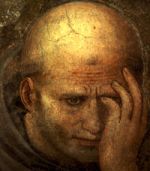Catholic World News News Feature
Toward the conclave #8: eligible candidates for the papacy April 13, 2005
In all likelihood, one of the 115 cardinals who enters the conclave on April 18 will emerge as the 265th Pope. But the electors are not required to choose one of their own number; they could choose any bishop, or even a simple priest.
The rule that will be followed in the election of a new Roman Pontiff, the Ordo Rituum Conclavis, allows for exceptional circumstances, including (in article 62) the possibility that the man selected is a "cardinal or a bishop" who is not present at the conclave. In that case the sostituto, or deputy Secretary of State (Archbishop Leonardo Sandri) is assigned to meet with the chosen individual personally-- using "prudence and circumspection" and taking care never to "violate the secrecy of the conclave"-- and bring him to Rome as quickly as possible. Once there, the individual is asked whether he will accept selection as the Roman Pontiff.
|
This scenario could be played out if the cardinal-electors chose a cardinal who is above the age of 80, and thus ineligible to participate in the papal election. These older cardinals-- the list includes respected prelates such as Cardinals Bernardin Gantin and Achille Silvestrini-- are not automatically disqualified by age from serving as Pope, although presumably the electors would weigh their age carefully before choosing them.
There are also 2 cardinals who were eligible to join in the conclave, but could not attend because of serious illness: Cardinals Jaime Sin, the retired Archbishop of Manila, and Adolfo Antonio Suarez Rivera, the retired Archbishop of Monterrey, Mexico. Again, their illness would make these prelates highly unlikely candidates for the papacy. Nevertheless they could theoretically be chosen.
Furthermore, the cardinal-electors are not required to choose a fellow cardinal as the next successor to St. Peter. Any bishop is eligible for the post. To cite just one unlikely but possible example, the conclave could opt for Archbishop Angelo Comastri, who in February was named by Pope John Paul as vicar of Vatican City, and is widely regarded as a future cardinal.
Still less likely, but not impossible, is the prospect that the conclave could choose a priest who is not yet a bishop. This possibility, too, is foreseen in the Ordo. Article 64 of that document stipulates that if a priest accepts election to the papacy, he must be consecrated as a bishop immediately, within the conclave, by the dean of the College of Cardinals (Cardinal Joseph Ratzinger). Then he would be qualified to serve, and ready to be introduced as the new Bishop of Rome.
No one seriously anticipates that any of these scenarios will be played out in the coming conclave. Far more likely, the cardinal-electors will select one of themselves. But Church history does afford examples of a Pope selected from outside the College of Cardinals, including some who were simple priests or monks. There is even the example of one hermit who was called to serve in the papacy: Pope Celestine V, in 1294. That example is not an altogether happy one, however; Pope Celestine resigned after a chaotic 6-month reign.
Probably a better historical example, closer to our time, was the conclave of 1958. At the death of Pope Pius XII, many observers believed that the Archbishop of Milan was the obvious choice to succeed him. But Archbishop Giovanni Montini had not yet received a cardinal's red hat, and so he was not present at the conclave. The cardinal-electors instead chose the Patriarch of Venice, Cardinal Angelo Roncalli, as Pope John XXIII. Five years later, at the next conclave, the Milan archbishop-- now Cardinal Montini-- was elected Pope Paul VI.






